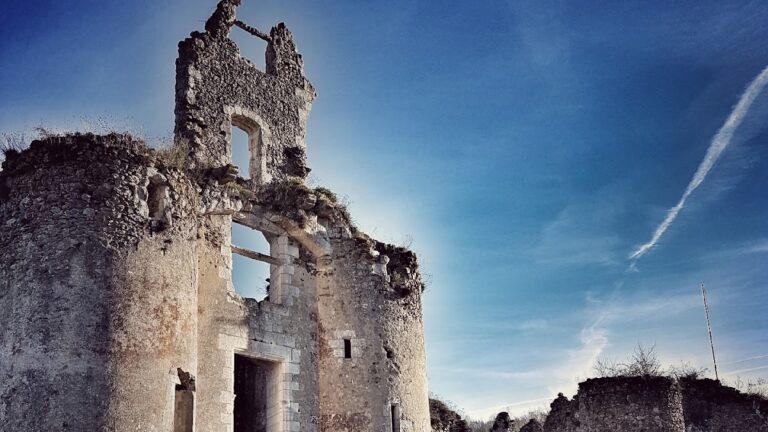Château de Champchevrier: A Historic French Estate with Medieval and Renaissance Heritage
Visitor Information
Google Rating: 4.6
Popularity: Low
Google Maps: View on Google Maps
Official Website: www.champchevrier.fr
Country: France
Civilization: Unclassified
Remains: Military
History
The Château de Champchevrier is situated in the municipality of Cléré-les-Pins in modern-day France. The site has a history that stretches back well over nine centuries, originating as a medieval fortress established by the seigneurial family of Champchevrier, who are recorded as early as the 11th century. This fortress formed the core of a feudal estate and witnessed multiple transitions in ownership among noble families through the Middle Ages and beyond.
During the 13th century, the estate came under the control of the Maillé family, who held the title of Luynes. It later passed into the hands of the Daillon du Lude family before eventually being sold in 1728 to descendants of Jean-Baptiste Pierre Henry de la Ruë du Can. This noble lineage, having inherited the barony of Champchevrier in 1741, has maintained continuous ownership of the property to the present day.
In the 16th century, significant changes reshaped the fortress when a Renaissance pavilion was erected atop the medieval foundations. This new structure displayed architectural elements common to the Renaissance era, such as distinctive mullioned windows. Notably, King Louis XIII stayed briefly at the château in 1619, marking the site’s connection to the royal presence during that period.
The 17th century saw further modifications, including the excavation of moats around the estate, a military undertaking led by the regiment commanded by the Duke of Roquelaure. Later, in the 18th century, the château underwent expansions with additional wings and terrace constructions, reflecting adaptations to the residential and representational needs of its noble occupants.
Apart from its architectural evolution, the estate became renowned for its long-standing tradition of hunting. In 1804, the château established what is recognized as France’s oldest mounted hunting pack. Its collection of mounted hunting equipment likewise represents the most ancient assembly of such items in the country, underscoring the estate’s historical association with this activity.
The château and its surrounding park have been officially protected as historic monuments since the mid-20th century. The landscape received recognition in 1945, followed by broader classification covering the castle, outbuildings, and gardens in 1975. Throughout its history, the château has preserved many elements of its heritage, including furnishings and tapestries from the 17th and 18th centuries, some originating from notable sources such as the Château de Richelieu and the royal manufactory of Amiens.
Remains
The core of the Château de Champchevrier consists of a main building dating to the 16th century. Constructed as a Renaissance pavilion upon the remnants of the earlier medieval fortress, it is distinguished by its characteristic mullioned windows—windows divided by vertical stone bars typical of the period. Originally, a prominent hexagonal tower containing the main staircase dominated the building, though this tower was demolished during 18th-century alterations.
The château’s northeast facade was extended in the 18th century with two-story wings topped by terraces. Along the principal facade, a substantial terrace featuring balustrades from the same century offers a broad platform for display and outdoor use. The original dormer windows, which protrude from the roof to allow light and air into the upper floors, were replaced during this time by round or oval windows known as “eyes of ox,” named for their shape.
Inside, the château retains richly decorated interiors. The main staircase features brightly painted wooden paneling transferred from the Château de Richelieu, revealing the reuse of high-quality 17th-century craftsmanship. Surrounding walls display floral and figurative painted wood panels, alongside areas adorned in Cordoban and Venetian leather, indicating a preference for luxurious surface treatments.
The château’s furnishings include well-preserved pieces from both the 17th and 18th centuries, such as items crafted in the Régence style popular in early 18th-century France. Among its textile treasures is a suite of tapestries titled “Les Amours des Dieux,” produced by the royal manufactory in Amiens and based on the designs of Simon Vouet, an influential French painter of the 17th century. Additionally, original Beauvais tapestries remain part of the interior decor.
Surrounding the château are moats dating from the 17th century, dug under the direction of the Duke of Roquelaure’s regiment. These water-filled ditches helped define and protect the estate. Within the grounds stand ancillary structures including a chapel predating 18th-century renovations, an older dovecote used traditionally for housing pigeons, and 18th-century outbuildings such as a small aviary called a fuye.
The wider park area boasts mature, century-old trees and a canal that crosses the grounds, forming part of the landscaped garden design. Flower beds and borders are planted with roses, peonies, lilies, and seasonal bulbs such as narcissus and cyclamen. In 1787, mulberry bushes were introduced to the estate as part of attempts to cultivate silkworms for sericulture.
Access to the château was once via a drawbridge, which was replaced in 1792 by an elegant wrought iron gate marking the main entrance. This gate and the entrance gardens, together with the canal and overall parkland, have been legally protected as historic monuments, reinforcing the site’s cultural and architectural significance.










